By the time I got there, Greg had already mustered about half the ewes into the paddock by the sheep yards. I got to stand strategically, make Big Scary Noises, and watch Ben and Kaya, the sheepdogs, do their job and get the sheep into the pens:

Watching sheep move like a school of fish really will never get old. (And actually, now that I look at that picture, it looks like Ben's doing all the work; the black spot within the concrete block at the very right of the picture is Kaya having a paddle in the cistern.)
Once we got the ewes in, Greg got to work getting the shearing stations ready and I got to work taking more pictures of sheep.

 When the shearers arrived, they started setting up, and Greg and I went back up to the top of the driveway to collect the rams for shearing as well. Greg gave me a four-wheeler and the task of getting the rams back to the sheepyards, which I was more than happy to do. I missed tearing around on four-wheelers!
When the shearers arrived, they started setting up, and Greg and I went back up to the top of the driveway to collect the rams for shearing as well. Greg gave me a four-wheeler and the task of getting the rams back to the sheepyards, which I was more than happy to do. I missed tearing around on four-wheelers! Look at 'em go! Except, as evidenced by the fact that I could take pictures and drive a four-wheeler at the same time, here's a shot of the spedometer:
Look at 'em go! Except, as evidenced by the fact that I could take pictures and drive a four-wheeler at the same time, here's a shot of the spedometer: Four kilometers an hour. Yeeee haw.
Four kilometers an hour. Yeeee haw.An eternity later, when I finally got the rams out to the sheepyards, the shearers were all set up and ready to go. There were four men and three women, most of them related, and it was amazing to watch them work. They had obviously been working together for a very long time, and seemed almost like a single machine rather than seven different people.
 Three of the men were up on the platform, doing the actual shearing, and the three women stood on the floor below, skirting the fleece as it came off, sorting the belly wool, neck wool, and dags into three different piles before taking the remaining fleece to the wool baler, that contraption in the center of the photo there. The sheep on this farm are Romney, Finn, Texel, and Perendale, all varieties that have been bred for meat rather than wool (even though I think the wool is really lovely!). So, rather than selling each fleece individually, the wool gets packed into bales and sent to an auction or an agent who will buy it for carpet wool.
Three of the men were up on the platform, doing the actual shearing, and the three women stood on the floor below, skirting the fleece as it came off, sorting the belly wool, neck wool, and dags into three different piles before taking the remaining fleece to the wool baler, that contraption in the center of the photo there. The sheep on this farm are Romney, Finn, Texel, and Perendale, all varieties that have been bred for meat rather than wool (even though I think the wool is really lovely!). So, rather than selling each fleece individually, the wool gets packed into bales and sent to an auction or an agent who will buy it for carpet wool.So when each shearer finished with a sheep, the woman on the floor would roll it up and heave it at the wool baler, aiming for either of those two wooden bins. The fourth guy there was in charge of the baler, and would take the fleeces the women threw him and pack them in those bins as tightly as possible. He started with his arms (I got to help with this bit, and my skin up to the elbows was buttery-soft from all the lanolin), but as the bins got more and more full, he just hopped in and stomped on it like he was making wine.
At first, I thought he had made a mistake--there was only a sack in the right-hand bin, and how was he going to get a sack on the left bin? Surely he couldn't pack them in any tighter. Wrong!
Once he had packed in the bins as tightly as possible (probably about 40-50 fleeces in each bin), he put a square of wood and a very heavy metal lid on top of the left bin, then winched the left bin up until it could easily swing over the right bin. Once they were stacked on top of each other, he secured a rather elaborate pulley system to the metal lid, and with a big lever on the backside of the assembly, slowly compacted aaaaall the already-well-packed wool from the left bin into the just-as-already-well-packed bin on the right. I half-feared and half-anticipated what would happen if the pulleys malfunctioned: a wool volcano! Sadly, they never did.
Each bale of wool weighed about 150-200 kilos, and by the end of the day there were about seven of these bales, representing about 250 ewes and about 18 rams. And this was just day one!
The sheep themselves, although sometimes nicked and slightly dazed, seemed little the worse for wear. However, their heads now seemed waaaay too big for their bodies:
The rams, meanwhile, just looked like football players with very short haircuts:
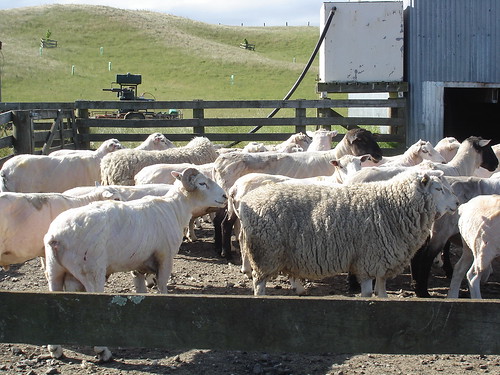
(Not sure what's going on with the shaggy guy in the front there--he may just have been too ornery to sit still for the shearing.)
Next up: big city living after two months of complete rural immersion. Do I still remember what traffic lights look like?
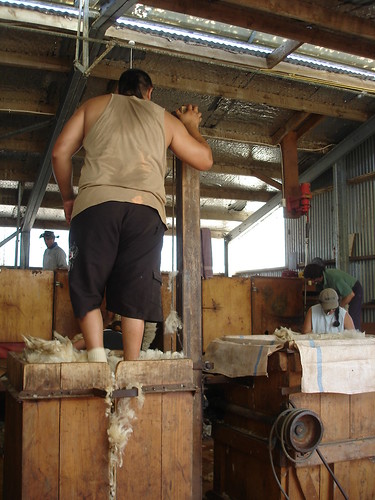

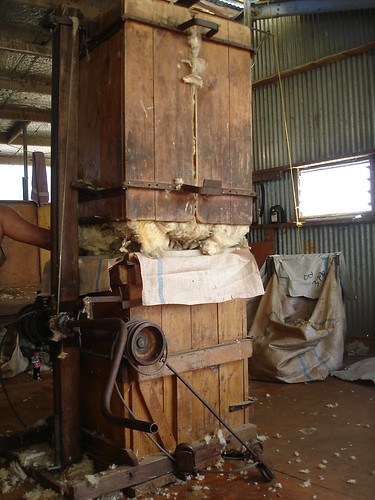
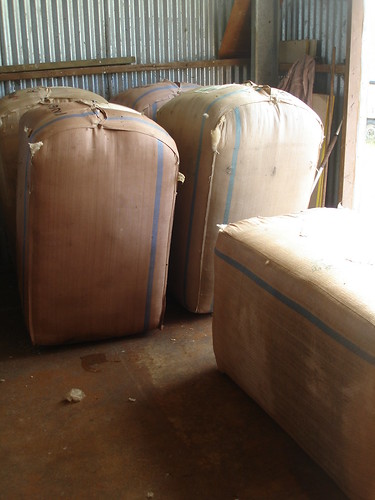
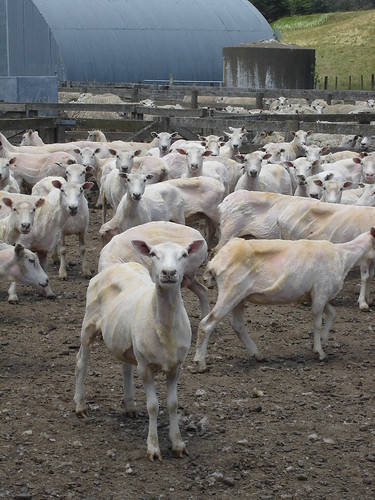
So many sheep! I can't believe how much the fleeces were compacted. Good luck in the big city!
ReplyDelete